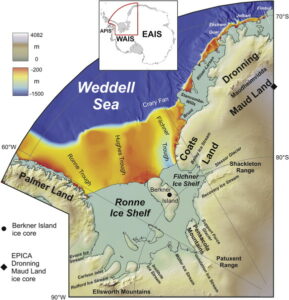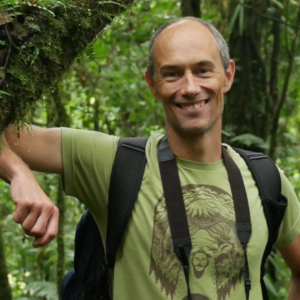Amid human disasters, some hope evolution can save us. Maine Professor Tim Waring worries evolutionary design may stop humans from solving climate change. New science: a major meltdown in Antarctica can happen not in thousands of years, but less than 200. That leads to a new age of rapid sea level rise around the world. Royal Society Research Professor Eric Wolff explains.
Listen to or download this Radio Ecoshock show in CD Quality (57 MB) or Lo-Fi (14 MB)
RECORD WILDFIRES PUSH CARBON UP – IN FEBRUARY
Before we get to our guests, climate heating is pushing extreme wildfires releasing megatonnes of carbon dioxide forcing more climate heating. That is the positive feed-back loop at work in this hottest twelve months recorded by humans, and possible in the last 3 million years.
We are seeing new fire phenomena. A prime example: north Texas was in a state of drought for several years recently, but not this winter of 2023/24. Yet the largest single fire in Texas history burned at least a million acres last week, over 400,000 hectares. Several other major fires burned in Texas and Oklahoma at the same time.
In recent fire history, Texas had two big fires in March – the Eastern Complex Fire in March 2022, and the East Amarillo Complex Fire in March 2006. But these were tiny compared to these 2024 fires in what used to be called the “dormant” period for fires, in February. Is climate involved? Studies are yet to come but we can observe there was a long-lasting hot winter in that area, with temperatures up to 94 degrees Fahrenheit, over 34 C. in Dallas.
Earth is experiencing flash droughts – science published last year finds. According to our guest Michael Flannigan, some soils can dry out in just three days of heat, leaving vegetation ready to burn – even after a fairly rainy time. I believe that is what happened in Texas. See this new science: “A global transition to flash droughts under climate change”.
WILDFIRES: MAJOR CO2 EMITTERS
These massive wildfires are not just local or regional disasters. Trees and bushed make trunks and branches out of carbon. Wood and even grass are essentially towers of carbon. When they burn, clouds of carbon dioxide goes into the atmosphere.
It has been difficult to find out how much carbon is coming from wildfires compared to our own emissions. Now with newer equipment, the The Copernicus Atmosphere Monitoring Service released fire emissions data from the South American fires. Not reported in mainstream news, the Northern Amazon, formerly considered a rainforest, has overheated and burned in just the last months.
Copernicus reports in just the month of February 2024, wildfires in Brazil, Venezuela, and Bolivia released about 9.3 megatonnes of carbon into the atmosphere. For comparison, the total CO2 emissions from the American transport sector – cars, trucks, and trains, was almost 1.6 megatonnes for the whole year of 2022. That means carbon emissions from South American wildfires just last month are about six times U.S. transport emissions for a whole year. All that is small compared to 480 megatonnes of carbon released by the 2023 wildfires in Canada, again according to Copernicus satellite measurements.
In central South America, wildfires in the last 12 months provided a major burst of carbon dioxide into the atmosphere – not just for days, but for months of an unbearably hot summer there. Even the rainforest is burning. Some of that carbon will be recaptured by regrowth, but the dense forest ecosystem is unlikely to return. Whatever is not recaptured by replacement growth will remain in the atmosphere for at least one hundred thousand years of warming.
The combination of high heat, extended wildfire seasons and flash droughts is now a positive feed-back loop. I’ve been on this beat for a while. I did not hear anyone predicting wildfire would become a major driver of global warming in the 2020’s. And yet here we are. Nature is taking over the big change, returning to a hot-house Earth.
Let’s get on to hard science about rapid climate change, followed by the big question: can humans change, and can they do it time?
===========================
ERIC WOLFF
RAPID MELTDOWN OF ANTARCTIC ICE
As the last ice age ended, the surface of the West Antarctic Ice Sheet shrank down about 1500 feet or 450 meters. All that ice did not disappear in thousands of years, but in less than 200, in two or three human lifetimes. As we rapidly heat the planet, be warned: Antarctic ice can change very quickly. So can coastlines around the world.

New evidence is revealed in a paper published in the journal Nature Geoscience. Co-author Eric W. Wolff is here to explain. He is a Royal Society Research Professor in the Department of Earth Sciences at Cambridge University. With 40 years of research and publishing, Eric is an Honorary Fellow at the British Antarctic Survey.
Listen to or download this 24 minute interview with Eric Wolff in CD Quality or Lo-Fi
The Weddell Sea on the coast of Antarctica is facing the Atlantic Ocean. Effectively it is a southern extension of the Atlantic. The coastline and ice behind it is about one sixth of Antarctica.

Hillenbrand et al. 2014.
The ice core oxygen isotopes revealed a large temperature change in that 200 year (or less) period. As other samples around Antarctica do not show that level of warming, this change could only have been caused by a decrease in altitude. As we know, temperatures get colder going up a mountain, and warmer coming down (on average). The scientists were able to calculate the big change in latitude, finding it about the same height as the Empire State Building – in 200 years or less.
This big change was not part of a long-term trend. The ice level ticked along about the same for thousands of years, and then suddenly rapidly changed. It sounds like a tipping point was reached – or does ice move like tectonic plates, building up pressure, and then suddenly releasing like an earthquake? Please listen to the interview and check out the paper for the real answers.
The actual cause of this collapse is hard to determine. From the models and the cores, scientists find the process likely built up over time and then suddenly released. So the cause may not be evident exactly when it happens. Likely that is true of many big changes we will see in this world as climate change develops. As Wolff tells us, it would have been difficult to predict when it would happen, but such a rapid ice loss is “not something we would like to experience in the future.”
The Weddell Sea ice is less in immediate risk of collapse than the Thwaites Glacier on the other side of the West Antarctic Peninsula. A study by Kate Naughten et al by the British Antarctic Survey showed a lot more warming is required to set loose the Weddell Sea glaciers, Wolff tells us.
But Wolff says this study shows what is probably a generic process, applicable anywhere there are ice shelves holding back glaciers (or at least slowing them down). Rapid ice retreat – from the coast, and fast shrinking – may be the way these systems work. If so, we may only know it is coming as it happens, and the whole process could be seen during your lifetime and the lives of your grandchildren.
The scientists estimate this Weddell Sea ice was losing about 2 meters, or about 7 feet of height per year. Note that glaciologist Jason Box has videos of equipment (like cameras and measuring stuff) set on poles driven into the ice on Greenland. The following year a ladder is required to reach the equipment, because so much ice has been lost. It is happening now, but could speed up rapidly in other places, according to the mechanism measured in this new study co-authored by Eric Wolff. This point of rapid retreat may be very near on the Thwaites Glacier – a gigantic pool of ice capable on its own of raising sea levels around the world.
Once the rapid retreat begins, it does not stop until the glacier reaches a new grounding line, like an upward ridge on the bottom where the ice rests. In the case of the Thwaites Glacier scientists think the ice loss will not stop until it releases 2 to 3 meters of global sea level rise. The retreat in the Weddell Sea is estimated (by models) to have released 1 to 2 meters (3 to 7 feet) of sea level rise around 8,000 years ago. The ice fell back until it reached a new grounding line, where it rests today.
ON VOLCANOES AND GEOENGINEERING
I ask Eric about his previous work studying ice cores to find the biggest volcanic eruptions over the last 200,000 years. These show up as a few years of high sulfur levels in the ice core. The one in one thousand year volcanic eruptions would have been difficult to survive, he says, as they would damage agriculture and bring short term weather changes. Then after about four years, the climate goes back to what it was.
He then discusses the idea of putting sulfates into the atmosphere to reduce warming – geoengineering. Wolff tells us science shows great worries about possible weather changes, including rainfall moving to different places – and questions about whether humans can keep it up, year after year. As soon as that geoengineering stops, the added heat from continuing emissions appears. I think that could be devastating. Radio Ecoshock has covered geoengineering for years.
Climate change is deleting important records of previous climates. Ice cores from East Antarctica are safe, but ice records in the European Alps, the Andes and other parts of the world are being wrecked. The ice does not have to completely disappear to damage the records. Once melt water starts dripping down through the layers, the ice core becomes unreadable. Wolff tells us some scientists are gathering ice records now and taking them to Antarctica for storage so continuing science will be possible. Of course that is a very limited sample and a last ditch effort.
SEE THIS NEW SCIENCE
Article Open access Published: 21 February 2024
Progressive unanchoring of Antarctic ice shelves since 1973
Bertie W. J. Miles & Robert G. Bingham Nature
========================
TIM WARING
IS EVOLUTION WORKING AGAINST US?
Can our evolutionary design stop humans from solving climate change? A new study finds environmental competition and conflict between sub-global groups work against global solutions. No wonder climate talks fail, as energy giants and consumerism compete to expand.

Dr. Timothy Waring models the “evolution of sustainable behaviors, institutions and social-ecological systems.” At the School of Economics and Mitchell Center, University of Maine, Tim Waring is Associate Professor of Applied Cultural Evolution. He developed models, co-founded international working groups and publishes heavily.
Listen to or download this 31 minute interview with Tim Waring in CD Quality or Lo-Fi
In the interview Tim cites Elinor Ostrom and her eight principles. He also talks about the East Coast lobster industry self-policing, as described by the late James Acheson, author of the book “The Lobster Gangs of Maine”.
To find out why the process of human cultural evolution may act against our hopes to create a sustainable civilization, you need to listen to the interview, or read the paper. Here is one article to explain a bit, and here is a small part of what Waring et al. say in the paper:
“…evolution in a population of sub-global groups favours the emergence of sub-global traits for environmental control: Earth supports a population of evolving sub-global groups. Evolution among entities in a shared environment favours adaptations for resource competition and extraction (e.g. [101]). Thus, there can be limited collective action towards environmental stability in the face of evolutionary competition between groups.”
“Therefore, the population structure necessary for the adaptive evolution of global cultural traits for environmental regulation is in conflict with the current and historical evolutionary processes acting on human groups. “
LOTS OF WAYS TO FOLLOW UP ON CULTURAL EVOLUTION!
The new paper on the Anthropocene – and developing an applied science of cultural revolution for sustainability – is available free on Tim’s web site. Download it for yourself. He says we still don’t know if humans can survive on a single planet in the long term. They are trying to do basic research, hopefully becoming a movement. The “Cultural Evolution Society” has just launched a new web site “a scientific society for the study of the evolution of human culture.”
And here is the link to the free to download paper:
“Characteristic processes of human evolution caused the Anthropocene and may obstruct its global solutions” Waring, Wood, and Szathmáry (2023) The group also maintains an email network called “Evolve and Sustain” also available on Tim’s web site
Look into The Sustainability Working Group and the Evolve and Sustain Network.
Thank you for listening, and caring about our world.
Alex
